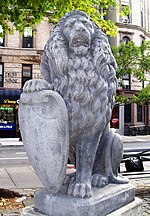Second Avenue Deli
Ashkenazi Jewish culture in New York CityEast Village, ManhattanFleischig restaurantsJames Beard Foundation Award winnersJewish delicatessens in the United States ... and 6 more
Jews and Judaism in ManhattanMurray Hill, ManhattanRestaurants established in 1954Restaurants in ManhattanUpper East SideUse mdy dates from February 2013

The Second Avenue Deli (also known as 2nd Ave Deli) is a certified-kosher Jewish delicatessen in Manhattan, New York City. In December 2007, it relocated to 162 East 33rd Street (between Lexington Avenue and Third Avenue) in Murray Hill. In August 2011, it opened a second branch at 1442 First Avenue (East 75th Street) on the Upper East Side. In November 2017, it opened a cocktail lounge called 2nd Floor above its Upper East Side branch.In 1998, the deli won an America’s Classic Award by the James Beard Foundation.
Excerpt from the Wikipedia article Second Avenue Deli (License: CC BY-SA 3.0, Authors, Images).Second Avenue Deli
2nd Avenue, New York Manhattan
Geographical coordinates (GPS) Address Nearby Places Show on map
Geographical coordinates (GPS)
| Latitude | Longitude |
|---|---|
| N 40.72954 ° | E -73.98674 ° |
Address
2nd Avenue 156
10003 New York, Manhattan
New York, United States
Open on Google Maps





